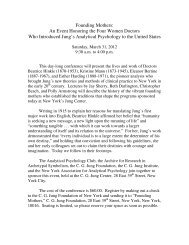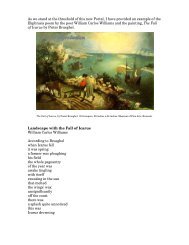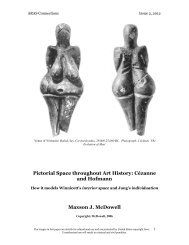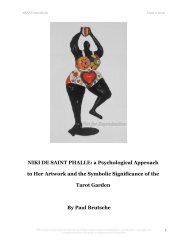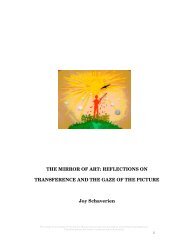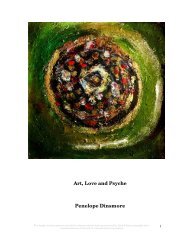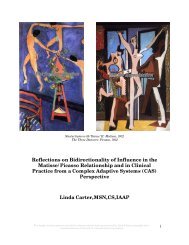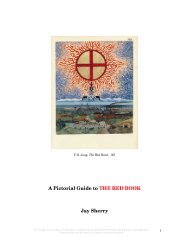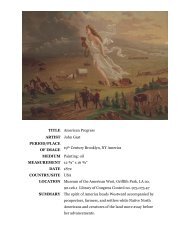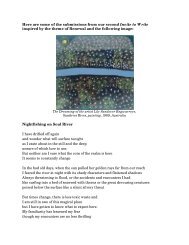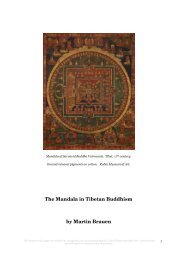PERMEABILITY Text: Margot McLean and James Hillman ... - ARAS
PERMEABILITY Text: Margot McLean and James Hillman ... - ARAS
PERMEABILITY Text: Margot McLean and James Hillman ... - ARAS
You also want an ePaper? Increase the reach of your titles
YUMPU automatically turns print PDFs into web optimized ePapers that Google loves.
<strong>PERMEABILITY</strong><br />
“the degree to which a solid allows the passage of fluid<br />
through it.”<br />
<strong>Text</strong>: <strong>Margot</strong> <strong>McLean</strong> <strong>and</strong> <strong>James</strong> <strong>Hillman</strong><br />
Artwork: <strong>Margot</strong> <strong>McLean</strong><br />
The images in this paper are strictly for educational use <strong>and</strong> are protected by United States copyright laws. Unauthorized use<br />
will result in criminal <strong>and</strong> civil penalties.<br />
1
<strong>Margot</strong> <strong>McLean</strong>:<br />
Milkweed<br />
While I stood here, in the open, lost in myself,<br />
I must have looked a long time<br />
Down the corn rows, beyond grass,<br />
The small house,<br />
White walls, animals lumbering toward the barn.<br />
I look down now. It is all changed.<br />
Whatever it was I lost, whatever I wept for<br />
Was a wild, gentle thing, the small dark eyes<br />
Loving me in secret.<br />
It is here. At a touch of my h<strong>and</strong>,<br />
The air fills with delicate creatures<br />
From the other world.<br />
<strong>James</strong> Wright<br />
Permeability is a state of being porous so that images may alight <strong>and</strong> find a<br />
resting place, <strong>and</strong> set off elaborations. These happen not necessarily in the<br />
The images in this paper are strictly for educational use <strong>and</strong> are protected by United States copyright laws. Unauthorized use<br />
will result in criminal <strong>and</strong> civil penalties.<br />
2
studio when concentrating on the work. They may even be impeded there.<br />
Similarly, elaborations of a dream into insights <strong>and</strong> recollections <strong>and</strong><br />
interpretations do not necessarily happen in the analytic session but require a<br />
permeability throughout the day after the session <strong>and</strong> the days after the session,<br />
here, there, or anywhere, <strong>and</strong> not with the analyst but with anyone.<br />
Artists work in an imagistic space. A space that has no beginning, no end, no<br />
middle. When is an artwork finished? When is a dream finished? The image<br />
seems to want to go on. Cézanne said a painting is complete at every stage of<br />
the work even if it is never finished.<br />
The images in this paper are strictly for educational use <strong>and</strong> are protected by United States copyright laws. Unauthorized use<br />
will result in criminal <strong>and</strong> civil penalties.<br />
3
<strong>James</strong> <strong>Hillman</strong>:<br />
INCURSIONS<br />
I am concerned, beyond art-making, with the psychology of the incoming, which<br />
the San Francisco poet Robert Duncan called the invenio, Catholicism calls the<br />
Annunciation—the descent of logos into physical matter, the all-too-solid flesh. I<br />
am concerned less with what comes in than with the incurring, the fact of human<br />
permeability, the ordinary, quotidian <strong>and</strong> ubiquitous fact of visionary, ideational,<br />
auditory, symptomatic, <strong>and</strong> personified incursions.<br />
Why can fantasy-thinking not be shut out?<br />
The composer, the painter, the writer are not special human exceptions. They are<br />
the subtle more vulnerable examples—not of “weak ego,” but of the essential<br />
nature of the human mind, that it is membranous, osmotic, susceptible,<br />
suggestible, seducible, seditious, hysterical.<br />
If so, then directed thinking’s ego is not the center of consciousness. Rather, this<br />
“ego-gesture” lives in the Zuyder Zee, below sea level among s<strong>and</strong>bags, thumbless<br />
against the holes in the dikes. “Close the door, they’re coming thru’ the window.<br />
Close the window, they’re coming thru’ the door.”<br />
How did Jung put it? The Psyche is not in you; you are in the psyche.<br />
The images in this paper are strictly for educational use <strong>and</strong> are protected by United States copyright laws. Unauthorized use<br />
will result in criminal <strong>and</strong> civil penalties.<br />
4
The images in this paper are strictly for educational use <strong>and</strong> are protected by United States copyright laws. Unauthorized use<br />
will result in criminal <strong>and</strong> civil penalties.<br />
5
BIRDS<br />
I walked out the back door, pulled it shut <strong>and</strong> headed to my studio. The birds<br />
were extremely loud forcing me to look up to see what was wrong. I saw nothing<br />
The images in this paper are strictly for educational use <strong>and</strong> are protected by United States copyright laws. Unauthorized use<br />
will result in criminal <strong>and</strong> civil penalties.<br />
6
unusual <strong>and</strong> didn’t break my pace walking across the driveway. BUT, as I kept<br />
heading in that very determined forward direction, I wondered to myself why was<br />
I thinking something was wrong. Perhaps something was very right. Or just was<br />
what it was. In this split second of thought, in the very short distance from house<br />
to studio, I was taken up, walked up, so to speak, to those yackety birds <strong>and</strong> then<br />
down again towards my studio. I hardly broke my pace. I was carrying a lot of<br />
“intentions,” things I wanted to do, finish, ideas I thought I had better get a start<br />
on, <strong>and</strong> even worse, I was already late. Once inside <strong>and</strong> closing the door the<br />
birds sounded even louder. What in the hell was going on up there? I was so<br />
utterly distracted by their raucousness, I had to go back out. There they were—<br />
medium sized crows some sitting <strong>and</strong> others jumping from branch to branch<br />
yacking away. I stood in the driveway for a long time <strong>and</strong> watched them until the<br />
last one, two, <strong>and</strong> three flew off. It was hard for me to go back inside— very<br />
similar to the feeling one has when not wanting to wake out of a dream.<br />
The images in this paper are strictly for educational use <strong>and</strong> are protected by United States copyright laws. Unauthorized use<br />
will result in criminal <strong>and</strong> civil penalties.<br />
7
The images in this paper are strictly for educational use <strong>and</strong> are protected by United States copyright laws. Unauthorized use<br />
will result in criminal <strong>and</strong> civil penalties.<br />
8
TWO KINDS OF THINKING<br />
In the beginning Jung declared two kinds of thinking, directed <strong>and</strong> dereistic or<br />
fantasy, one above <strong>and</strong> one below. These two kinds of thinking open the great<br />
The images in this paper are strictly for educational use <strong>and</strong> are protected by United States copyright laws. Unauthorized use<br />
will result in criminal <strong>and</strong> civil penalties.<br />
9
ook, Symbols of Transformation which explores the ways of the second, fantasy<br />
kind, or the Psychology of the Unconscious as that great book was first titled in<br />
the English translation by Beatrice Hinkle in 1916.<br />
Only later in the revised version of 1952, did the above <strong>and</strong> below become the ego<br />
<strong>and</strong> the unconscious, concepts latched onto <strong>and</strong> clutched still by Jungian<br />
orthodoxy. Conventionalists. The word “ego” however, does not show up in the<br />
Hinkle index, <strong>and</strong> is inserted into the edition we study in the Collected Works, as<br />
part of Jung’s much later exp<strong>and</strong>ed revisions.<br />
Two kinds of thinking, directed <strong>and</strong> dereistic, frame our psychological cosmology.<br />
They belong to our creation myth, <strong>and</strong> they are given testimonial witness by Jung<br />
in his autobiography as Personality Number One <strong>and</strong> Number Two. How does<br />
fantasy thinking proceed, what is it like? William <strong>James</strong>—upon whom Jung here<br />
relies (CW5: para 18)—describes it as “trains of images,” “spontaneous,”<br />
“irresponsible,” “accidental,” <strong>and</strong> composed of “empirical concretes.”<br />
The images in this paper are strictly for educational use <strong>and</strong> are protected by United States copyright laws. Unauthorized use<br />
will result in criminal <strong>and</strong> civil penalties.<br />
10
Trains of images that are empirical concretes. The train crosses over into the<br />
terrain of Bachelard’s material imagination. The stuff of things; the sensate, the<br />
tactile, the colored, noise <strong>and</strong> smell, <strong>and</strong> strings of words. The stuff of the arts:<br />
“empirical concretes.”<br />
“Aesthetics is for the artist as<br />
ornithology is for the birds.”<br />
Barnett Newman.<br />
The images in this paper are strictly for educational use <strong>and</strong> are protected by United States copyright laws. Unauthorized use<br />
will result in criminal <strong>and</strong> civil penalties.<br />
11
EMPIRICAL CONCRETES.<br />
The stuff of the arts. But not just anything colored, anything soft <strong>and</strong> sensuous,<br />
or smelly, allows for the imagination to materialize. Because: Bachelard says<br />
these concretes must themselves have a fundamental <strong>and</strong> lasting ambivalence.<br />
Compare: Jung’s bipolarity of the archetype.<br />
Compare: Freud’s “Antithetical Sense of Primal Words” (1910).<br />
This fundamental ambivalence of the material itself is conceived by aesthetic<br />
theory as the sublime aspect of beauty. Let me explain: “Singleness of meaning<br />
is only superficial imagination,” says Bachelard. Material that only is what it is,<br />
uncomplicated, unambiguous yields only the sentimental <strong>and</strong> the pretty. The<br />
The images in this paper are strictly for educational use <strong>and</strong> are protected by United States copyright laws. Unauthorized use<br />
will result in criminal <strong>and</strong> civil penalties.<br />
12
concrete must offer depth to be truly imaginative <strong>and</strong> this depth is conceived in<br />
the theory of the sublime as dark, vast, boundless, awe-full, terror-arousing, etc.<br />
The incredible beauty of Hades <strong>and</strong> Persephone in the studio, unintended but<br />
imported by the concrete, the empirical materials themselves—their composite<br />
mystery. Even a simple tube of bought paint presents an awe-full intensity of<br />
possible depths. Wherever incurring: as the objet trouve, the bird’s wing, bit of<br />
shell, or bark, pebble, reed, clawfoot, old newspaper, rag, button, downward<br />
descending drip, or invasive overvalued word, or sudden pang or pain.….<br />
“In art there is only one thing that counts; the thing you can’t explain.”<br />
Georges Braque, Notebooks (1917-47)<br />
The images in this paper are strictly for educational use <strong>and</strong> are protected by United States copyright laws. Unauthorized use<br />
will result in criminal <strong>and</strong> civil penalties.<br />
13
Hades <strong>and</strong> Persephone, their complexity, their ambivalence; their horror in the<br />
beauty. Thanatos inside all empirical concretes; death inside all things. Artist as<br />
thanatologist, psychopompos.<br />
The images in this paper are strictly for educational use <strong>and</strong> are protected by United States copyright laws. Unauthorized use<br />
will result in criminal <strong>and</strong> civil penalties.<br />
14
One of Proust’s characters, the writer Bergotte, expires in front of a Vermeer.<br />
“The circumstances of his death were as follows. . .Bergotte ate a few potatoes,<br />
left the house, <strong>and</strong> went to the exhibition. At the first few steps he had to climb,<br />
The images in this paper are strictly for educational use <strong>and</strong> are protected by United States copyright laws. Unauthorized use<br />
will result in criminal <strong>and</strong> civil penalties.<br />
15
he was overcome by an attack of dizziness. He walked past several pictures <strong>and</strong><br />
. . at last he came to the Vermeer which he remembered as more striking, more<br />
different from anything else he knew, but in which he noticed for the first time<br />
some small figure in blue, that the s<strong>and</strong> was pink, <strong>and</strong>, finally, the precious<br />
substance of the tiny patch of yellow wall. ‘That’s how I ought to have written,’ he<br />
said. ‘My last books are too dry, I ought to have gone over them with a few layers<br />
of colour, made my language precious in itself, like this little patch of yellow wall.’<br />
Meanwhile he was not unconscious of the gravity of his condition. In a celestial<br />
pair of scales there appeared to him, weighing down one of the pans, his own life,<br />
while the other contained the little patch of wall so beautifully painted in yellow.<br />
He felt that he had rashly sacrificed the former for the latter. He repeated to<br />
himself; ‘Little patch of yellow wall, with a sloping roof, little patch of yellow wall.’<br />
Meanwhile he sank down on to a circular settee; whereupon he suddenly ceased<br />
to think that his life was in jeopardy <strong>and</strong>, reverting to his natural optimism, told<br />
himself: ‘It’s nothing, merely a touch of indigestion from those potatoes, which<br />
were under-cooked.’ A fresh attack struck him down; he rolled from the settee to<br />
the floor, as visitors <strong>and</strong><br />
attendants came<br />
hurrying to his<br />
assistance. He was<br />
dead.”<br />
The images in this paper are strictly for educational use <strong>and</strong> are protected by United States copyright laws. Unauthorized use<br />
will result in criminal <strong>and</strong> civil penalties.<br />
16
Don’t come to me with the entire truth.<br />
Don’t bring the ocean if I feel thirsty<br />
nor heaven if I ask for light;<br />
But bring a hint, some dew, a particle,<br />
as birds carry only drops away from water,<br />
<strong>and</strong> the wind a grain of salt.<br />
Each stone its shape<br />
Each shape its weight<br />
Each weight its value<br />
In my garden as I dig them up for Spring planting,<br />
<strong>and</strong> I say, lifting one at a time,<br />
There is joy here<br />
In being able to h<strong>and</strong>le<br />
so many meaningful<br />
differences.<br />
David Ignatow<br />
Olav H. Hauge (translation Robert Bly)<br />
The images in this paper are strictly for educational use <strong>and</strong> are protected by United States copyright laws. Unauthorized use<br />
will result in criminal <strong>and</strong> civil penalties.<br />
17
THE AVIARY<br />
Socrates, in Plato’s Theatetus (197 ce), says the mind is “like a man who has<br />
caught some wild birds <strong>and</strong> keeps them in an aviary he has made for them at<br />
The images in this paper are strictly for educational use <strong>and</strong> are protected by United States copyright laws. Unauthorized use<br />
will result in criminal <strong>and</strong> civil penalties.<br />
18
home. In a sense, of course, we might say he ‘has’ them all the time inasmuch as<br />
he possesses them. . . But in another sense he ‘has’ none of them, though he has<br />
got control of them, now that he has made them captive in an enclosure of his<br />
own. . . So now let us suppose that every mind contains a kind of aviary stocked<br />
with birds of every sort, some in flocks apart from the rest, some in small groups,<br />
<strong>and</strong> some solitary flying in any direction.”<br />
BAG LADY<br />
I have a large, invisible sack I carry with me at all times. It’s full of miscellaneous<br />
folders <strong>and</strong> envelopes where I try to keep “things” in order. It is never always full<br />
<strong>and</strong> at the same time, it is hardly ever empty. Sometimes the “things” get lost<br />
inside but I try not to worry about it too much. Images, thoughts, impressions,<br />
questions, insights, voices, ideas, emotions, reactions are flying past all the time.<br />
I just have to wait long enough for one to l<strong>and</strong>. And, everything that l<strong>and</strong>s goes<br />
The images in this paper are strictly for educational use <strong>and</strong> are protected by United States copyright laws. Unauthorized use<br />
will result in criminal <strong>and</strong> civil penalties.<br />
19
into the sack as I don’t feel it’s a good idea to make a hasty decision as to<br />
whether or not, whatever it is, is worth keeping. I’ve made mistakes—have<br />
gotten rid of “things,” wishing I hadn’t. But that’s the way these “things” operate.<br />
Their movement is mysterious—fooling you whenever they can—shapeshifting<br />
into things they are not, making you work to find out what they are.<br />
I can’t say I really underst<strong>and</strong>—but I do somehow comprehend. I actually resist<br />
trying to make sense of these things because, again, I have no idea what<br />
“making sense” means. And as we all know, the<br />
will has its own distinct tendency to go beyond<br />
its own borders, making it very difficult for any-<br />
thing else to participate. The will becomes blind<br />
to everything but what serves its ultimate goal. It<br />
can corrupt itself easily.<br />
CHALLENGE<br />
“By the turn of the century—1900—nothing,<br />
absolutely nothing, was on certain ground;<br />
everything was being challenged; this is the main<br />
fact of our lives.” Alfred North Whitehead.<br />
Psychoanalysis met the challenge of uncertainty<br />
by constructing theories, schools, methods of practice, certification, <strong>and</strong><br />
protective authorization by the state. Psychoanalysis built a strong box in which<br />
The images in this paper are strictly for educational use <strong>and</strong> are protected by United States copyright laws. Unauthorized use<br />
will result in criminal <strong>and</strong> civil penalties.<br />
20
the fearful toxic effects of uncertainty—“the age of anxiety” as Auden named it—<br />
could be safely held. By renaming uncertainty “the unconscious” psychoanalysis<br />
incorporated the challenge within its own system, <strong>and</strong> depotentiated the<br />
autonomous, unpredictable, spontaneity of uncertainty.<br />
The nomenclature, diagnostics, codes <strong>and</strong> rules wall-off the alien immigrants<br />
who are translated, required to express themselves in the hosts’ language, <strong>and</strong> so<br />
they no longer threaten the status quo. The DSM—a textbook from homel<strong>and</strong><br />
security.<br />
The artist, however is left exposed<br />
<strong>and</strong> actually lives “this main fact of<br />
our lives” (Whitehead’s phrase)<br />
unprotected. Hence, the artist<br />
represents the never-ending<br />
challenge of uncertainty. Artist:<br />
emissary of the strange, the alien.<br />
The artist is an angelos of anxiety,<br />
the fearful, while the analyst has been<br />
instructed in anxiety-allaying<br />
techniques, knows re-framing,<br />
providing a “safe container” with<br />
“unconditional positive regard.”<br />
The images in this paper are strictly for educational use <strong>and</strong> are protected by United States copyright laws. Unauthorized use<br />
will result in criminal <strong>and</strong> civil penalties.<br />
21
VULTURES: THE TRUE ENVIRONMENTALISTS<br />
Just the word VULTURE sets off fear. They feed on the dead. It is precisely this<br />
appetite for the dead <strong>and</strong> what they do with it that interests me. They consume<br />
the rotten, decaying, often disease-ridden, <strong>and</strong> they poop out clean<br />
biodegradable stuff that composts. Without their amazing enzyme system we<br />
would be in danger. But–aren’t we already in danger? Vultures entered my life<br />
perhaps because of the abundance of deadness in our political leaders, in our<br />
regard for the environment, in the education of our people, in the actual dead of<br />
war.<br />
The sad trouble is: the vultures are dying—poisoned—primarily in Asia—by the<br />
use of the anti-inflammatory drug, diclofenac, given to cattle from which the<br />
vultures feed.<br />
The images in this paper are strictly for educational use <strong>and</strong> are protected by United States copyright laws. Unauthorized use<br />
will result in criminal <strong>and</strong> civil penalties.<br />
22
AGENCY<br />
What about agency? Who, after all, is the maker in art-making? Someone holds<br />
the mallet, the chisel, the brush, the camera, the spray can. Yes, indeed, that<br />
someone is a h<strong>and</strong>. H<strong>and</strong>s are the agent in response to the empirical concrete.<br />
The h<strong>and</strong>s sometimes do try to take orders from the personality above, Number<br />
One; then, of a sudden, they find themselves being pushed around by the<br />
material. Off they go. A caprice.<br />
A story: a monkey came out of the sack one day—a baby monkey. A sad baby<br />
monkey, I thought. “This is not a happy situation here <strong>and</strong> the darkness is<br />
evident.” I worked a very long time, a VERY LONG time on this painting—<br />
squeezed black paint mixed with powdered charcoal <strong>and</strong> deep blue pigments—<br />
over <strong>and</strong> over, again <strong>and</strong> again. My intention had been set, was determined,<br />
vision clear. The monkey rebelled. Before I obliterated the poor thing that I was<br />
actually very fond of, my h<strong>and</strong> went for the white gesso. I don’t remember how<br />
it happened—the monkey calmed down—I calmed down <strong>and</strong> the painting came<br />
to a conclusion.<br />
The images in this paper are strictly for educational use <strong>and</strong> are protected by United States copyright laws. Unauthorized use<br />
will result in criminal <strong>and</strong> civil penalties.<br />
23
When painting, you think your way through by “doing” your way through.<br />
AGENCY, con’t.<br />
May we imagine psychoanalysis as a h<strong>and</strong>-work, as alchemy was? Why not<br />
imagine ourselves as butchers <strong>and</strong> bakers, weavers <strong>and</strong> potters, as firemen even,<br />
containing a blaze. “Practicing” applies as well to musicians who sit on a chair for<br />
hours at a time working their trade much as we do. Though our analytical h<strong>and</strong>s<br />
are sheerly metaphorical, nonetheless, it is a h<strong>and</strong>work in the material. Like<br />
alchemy.<br />
As <strong>James</strong> Wright said in the opening poem: “It is here. At a touch of my h<strong>and</strong>,<br />
The air fills with delicate creatures from the other world.”<br />
The eye <strong>and</strong> the mind engage the concrete by following the h<strong>and</strong>, as the pianist<br />
says, “my h<strong>and</strong>s follow the music.” By analogous extension—the dancer’s foot,<br />
the poet’s ear <strong>and</strong> heartbeat <strong>and</strong> breathing; the actual feel <strong>and</strong> flow of the<br />
empirical concrete.<br />
The agent is matter (philosophically, since Aristotle, wrongly conceived as utterly<br />
passive). Hence Bachelard’s corrective volumes on the agency of elemental<br />
matter. The agent is matter(—but not desiring to escape as a bottled up spirit)<br />
instead, the liquidity of Mercurius enjoying the heavy, uncertain idiosyncrasies of<br />
the metal.<br />
The images in this paper are strictly for educational use <strong>and</strong> are protected by United States copyright laws. Unauthorized use<br />
will result in criminal <strong>and</strong> civil penalties.<br />
24
Human control, says Jung about agency, is not able “to separate that unruly <strong>and</strong><br />
evasive Mercurius from the autonomy of matter” (CW 13: 286).<br />
Sometimes, the h<strong>and</strong>s grab the matter by the throat <strong>and</strong> try to force it to obey.<br />
Rather than agency as the human will, its Willfulness; more the Shakespearean<br />
feeling of service, “willingly, my liege,” “willingly, your humble servant.”<br />
Agency: “Nature fights nature,” say the alchemists, but then they say “nature<br />
conquers nature.” But alchemy leaves uncertain which nature conquers, does not<br />
say who finally submits, willingly.<br />
The images in this paper are strictly for educational use <strong>and</strong> are protected by United States copyright laws. Unauthorized use<br />
will result in criminal <strong>and</strong> civil penalties.<br />
25
THE IMAGE<br />
Mikel Dufrenne says, to experience a painting in order to learn its lesson, receive<br />
its gift, one must inhabit its world. This experiencing is instructive precisely in the<br />
The images in this paper are strictly for educational use <strong>and</strong> are protected by United States copyright laws. Unauthorized use<br />
will result in criminal <strong>and</strong> civil penalties.<br />
26
sense that after entering the image, after experiencing its embrace, the seer<br />
experiences the real more deeply, sees what was previously “invisible,” feels<br />
what was previously “inaccessible.” In this way “aesthetic experience tends to<br />
correct the deficiency inherent to perception.”<br />
An artist friend emailed me after a studio visit to say she has been seeing crows<br />
very differently at her house upstate since her visit.<br />
In this way “aesthetic experience tends to correct the deficiency inherent to<br />
perception.”<br />
DEAR ANNA FREUD,<br />
I remember watching <strong>and</strong> hearing you lecture 50 years ago—lovely, frail, poised.<br />
Yet, your book The Ego <strong>and</strong> the Mechanisms of Defense my goodness! Such<br />
political, military language! Clausewitz, Wolfowitz.<br />
The images in this paper are strictly for educational use <strong>and</strong> are protected by United States copyright laws. Unauthorized use<br />
will result in criminal <strong>and</strong> civil penalties.<br />
27
(p. 6) ego <strong>and</strong> id as “two neighboring powers”; impulses as “intruders” “forcing<br />
their way”<br />
(p. 7) “hostile incursions”; “inroads” (p. 9)<br />
(p. 8) “All the defensive measures of the ego . . . are carried out silently <strong>and</strong><br />
invisibly.”<br />
(p.8) “The ego . . . counter-attacks . . . to put the [intruders] permanently out of<br />
action by means of appropriate defense measures.”<br />
May we suggest re-titling your important book by shifting the “<strong>and</strong>”<br />
to “is” “The Ego is a Mechanism of Defense Against Permeability.<br />
“Militarism” is that what the idea of ego does to us?<br />
FLAMINGOS<br />
Years ago, a friend gave me two white plastic flamingos wearing Santa Hats—<br />
you know, the kind you stick in your lawn (she was from Southern California).<br />
The images in this paper are strictly for educational use <strong>and</strong> are protected by United States copyright laws. Unauthorized use<br />
will result in criminal <strong>and</strong> civil penalties.<br />
28
Well, these flamingos appeared one day, as I opened the shed to get a shovel<br />
needed to bury a chicken that had just died. There they were, lying on top of a<br />
pile of junk. As I began digging, I thought about my friend who gave me the<br />
flamingos as she had just died the week before <strong>and</strong> I was with her when she took<br />
her last breath. I was never attracted to the idea of painting flamingos simply<br />
because of their appropriation by kitsch. Like dolphins, they are difficult subjects.<br />
But something happened. The plastic flamingos started moving. Into my studio<br />
they came.<br />
The images in this paper are strictly for educational use <strong>and</strong> are protected by United States copyright laws. Unauthorized use<br />
will result in criminal <strong>and</strong> civil penalties.<br />
29
The images in this paper are strictly for educational use <strong>and</strong> are protected by United States copyright laws. Unauthorized use<br />
will result in criminal <strong>and</strong> civil penalties.<br />
30
LIQUIDIFICATION<br />
“Perform no operation until all has become water.” The solutio in alchemy. So,<br />
what has to dissolve?<br />
Coagulated structures, attachments, habits of mind <strong>and</strong> feeling, cages. Shall we<br />
say “adaptations that work,” for which the shorth<strong>and</strong>, “ego.” Jung spoke of<br />
directed thinking as an effort, tiring. Freud said maintaining repression uses<br />
energy.<br />
Then what is the liquid that permeates <strong>and</strong> effects the solution? What happens,<br />
Jung asks (CW 5: para 18), when we no longer direct our Thinking? Well, we no<br />
The images in this paper are strictly for educational use <strong>and</strong> are protected by United States copyright laws. Unauthorized use<br />
will result in criminal <strong>and</strong> civil penalties.<br />
31
longer compel our mind along a definite track, but let its contents, he writes,<br />
“float, sink or rise according to their specific gravity.”<br />
“For my part I want to lose myself in nature <strong>and</strong> grow again with her, like her . . .<br />
in a patch of green, my entire brain will flow with a sap-like tide of the tree . . .<br />
The immensity <strong>and</strong> torrent of the world, in a tiny inch of water.”<br />
Cezanne<br />
The images in this paper are strictly for educational use <strong>and</strong> are protected by United States copyright laws. Unauthorized use<br />
will result in criminal <strong>and</strong> civil penalties.<br />
32
And, when Jung discusses origins of language he turns to the sound of flowing<br />
water (CW 5, para 12).<br />
Bachelard: “Liquidity is in the very desire of language.” “Language needs to<br />
flow”” Logorhea! Bachelard (188) “The great domain for studying the<br />
imagination is not painting; it is literature, the word, the sentence . . .How<br />
dominant matter becomes! What a great master the stream is!”<br />
The images in this paper are strictly for educational use <strong>and</strong> are protected by United States copyright laws. Unauthorized use<br />
will result in criminal <strong>and</strong> civil penalties.<br />
33
Permeability: inflow,<br />
ongoing streaming.<br />
Joyce’s everongoing<br />
Wake. The River Liffey’s<br />
last line of Finnegan: “I<br />
sink. . .humbly, dumbly,<br />
only to washup . . We<br />
pass through grass behush the bush. . .Whish! A gull. Gulls. Far calls. Coming,<br />
far! End here. Us then. Finn, again. . .mememormee. . .A way a lone a last a<br />
loved a long the. . .”<br />
Speech without punctuation; beware<br />
fricatives, labials. The vowels of<br />
permeability: Ah. Oh. Eee. “Liquidity<br />
is the principle of language,” says<br />
Bachelard, “language must be filled with<br />
water.”<br />
“Everything in the Universe is an echo”<br />
says Bachelard “And birds,” he says “are<br />
the first creators of sound.” From their<br />
sudden permeance, we learned poetry.<br />
“A gull,” says the river Liffey, “Gulls. Far<br />
The images in this paper are strictly for educational use <strong>and</strong> are protected by United States copyright laws. Unauthorized use<br />
will result in criminal <strong>and</strong> civil penalties.<br />
34
calls.” Bachelard: “Imagination is a sound-effects man; it must amplify or<br />
soften.” That is the agency, that is the willing work: tuning in, turning up, dying<br />
down. “Amplify or soften.”<br />
All things flow: Panta Rhei: The oldest insight of Western philosophy.<br />
<strong>PERMEABILITY</strong>, AGAIN<br />
The deepest divide, the biggest bulwark blocking permeability is that wall<br />
between the living <strong>and</strong> the dead. The absolute either/or behind, below, within all<br />
The images in this paper are strictly for educational use <strong>and</strong> are protected by United States copyright laws. Unauthorized use<br />
will result in criminal <strong>and</strong> civil penalties.<br />
35
our Western opposites: the living are positively not dead, <strong>and</strong> the dead are<br />
positively not living. Tertium non datur.<br />
Suppose we were to shift our geographic privileging of Greece, its delight in<br />
sunlight, its Apollo. Shift from Descartes clear distinctions opposed to Dionysian<br />
confusions <strong>and</strong> opposed to Hades indiscernible silent shades. Shift to the<br />
geography of China, Korea, Japan—the coming in <strong>and</strong> going out of images. Is the<br />
mountain emerging from the fog or receding into it? Near <strong>and</strong> Far, both.<br />
Suppose we imagine the dead are partly living <strong>and</strong><br />
the living are partly dead, inhabitants of both all the<br />
time, essentially. Receding <strong>and</strong> emerging always.<br />
Does this account for the romantic fantasy of the<br />
artist as courting death. Perhaps, in fact, the artist<br />
courts death, must court death. So that his/her<br />
living is a living death. Courts death with<br />
romanticized “self-destructive tendencies”; illness,<br />
drugs, drink, risk <strong>and</strong> folly. A vibrant life among<br />
shades.<br />
So that someone with softened or amplified<br />
permeability—the artist say— is a companion of the<br />
dead <strong>and</strong> is more with the dead than those who live<br />
The images in this paper are strictly for educational use <strong>and</strong> are protected by United States copyright laws. Unauthorized use<br />
will result in criminal <strong>and</strong> civil penalties.<br />
36
only on this side of the wall, walled off, merely living—the denial of death.<br />
Artist. Resident of bothville.<br />
ANTHROPOS<br />
Recovering Jung’s million-year old ancestor.<br />
Stanley Diamond writes: indigenous peoples <strong>and</strong> artists “focus on the singularity<br />
of the object to such a degree that everything seems at once marvelous, strange,<br />
familiar <strong>and</strong> unexpected . . . the [phenomenon] has become inc<strong>and</strong>escent. He is<br />
perpetually recovering his primitivism” (Cheetham; Diamond 1974, p.196).<br />
The images in this paper are strictly for educational use <strong>and</strong> are protected by United States copyright laws. Unauthorized use<br />
will result in criminal <strong>and</strong> civil penalties.<br />
37
Paul Radin writes: Not all reality resides in our external perception of it. The<br />
reality of a [phenomenon or] object is proved by . . . internal effects. The<br />
primitive is thus literally living in a blaze of reality.”<br />
“We do not look, we shall never look enough, never carefully enough, never<br />
passionately enough.”<br />
Colette<br />
Oscar Wilde: “Looking at something is not seeing it, <strong>and</strong> seeing it is seeing its<br />
beauty.”<br />
The images in this paper are strictly for educational use <strong>and</strong> are protected by United States copyright laws. Unauthorized use<br />
will result in criminal <strong>and</strong> civil penalties.<br />
38



